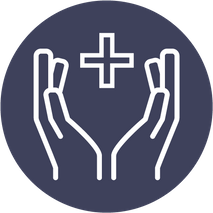
Physical Therapy Arm Pain
AT EVOLVE
Physical Therapy for arm Pain
HOW CAN PHYSICAL THERAPY ADDRESS ARM PAIN?
Arm pain is a common complaint treated by physical therapists. There are many different causes of arm pain ranging from acute injuries to chronic conditions and your physical therapist will work with you and your doctor, if needed, to determine an underlying cause and create a treatment plan to address your pain. Physical therapists use manual therapy techniques, modalities, exercises and other treatments to reduce pain and address underlying causes.
WHAT DOES PHYSICAL THERAPY TREATMENT FOR ARM PAIN LOOK LIKE?
Physical therapy treatments for arm pain are aimed at reducing the pain, addressing underlying factors and facilitating return to full activity. My team of therapists and I will start by getting to know your concerns and goals and performing a thorough physical exam to determine what may be causing the pain (if this isn’t already known) and also to decide which areas of the arm we should target with our physical therapy interventions. Your therapist will employ manual therapy interventions to target joint and tissue mobility while also prescribing movements and exercises for strength, motor control and mobility to be performed in the home and the clinic.
HOW LONG WILL I NEED PHYSICAL THERAPY?
The duration of your physical therapy plan of care will vary depending on the severity of symptoms, what is causing the pain as well as the types of activities you aim to resume. While full resolution of symptoms can take some time, you may begin to see some results right away. You should experience improvements in many symptoms such as pain, stiffness, and inflammation within a couple of weeks though the full return to pain-free activities will likely take longer. Achieving long-lasting results may take some time, but dedication to your program will help you achieve these results and decrease the likelihood of symptoms recurring.
POSSIBLE CAUSES OF ARM PAIN
The arm can be divided into the upper arm and the forearm. There are many potential causes of pain in the arm. Sometimes arm pain can be referred from a structure elsewhere in the body. Here are some of the common causes of arm pain:
Shoulder conditions can cause upper arm pain-
- Arthritis
- Impingement
- Rotator cuff tendinopathy or tears
- AC joint sprain
- Fracture
Upper arm conditions can cause pain near the shoulder, upper arm and below the elbow-
- Bicipital tendinopathy
- Triceps tendinopathy
- Strain of the biceps, brachioradialis or triceps
- Fracture
Elbow region conditions causing pain-
- Cubital tunnel syndrome
- Arthritis
- Ligament sprain or tear
Forearm conditions causing pain-
- Carpal tunnel syndrome
- Golfer’s or Tennis Elbow
- Fracture
Referred or neuropathic pain-
- Thoracic outlet syndrome
- Cervical radiculopathy
- Complex Regional Pain Syndrome
- Brachial Plexus Injury
Determining the cause of arm pain is important. If you schedule a visit with a physical therapist before seeing your doctor, a process called direct access, your physical therapist will use observation, palpation, special tests and other exam elements to try and localize the cause of your pain. Though not always needed, when indicated, your therapist may refer you to an orthopedic physician to request imaging such as an x-ray, MRI or ultrasound to visualize the structures of the arm to diagnose the cause of your pain. In other cases, lab work or other tests may be indicated to rule out underlying medical conditions. Physical therapy is an excellent treatment option for arm pain, however, in some cases, you may need additional medical treatments or surgery to achieve full resolution of symptoms.
Call to Schedule a Consultation! 1-718-258-3300End Injury Progression
Physical therapy for arm pain has proven to prevent injury, slow and even stop pain issues, improve performance, and reverse injury progression in many cases.
Relieve Pain
The movements used in this technique can target your entire body helping you to manage discomfort and pain during the course of your physical therapy treatments.
Improve Range of Motion
Posture awareness is an important area to focus on due to the fact that certain positions may cause you further discomfort and pain.
Restore Mobility
You can regain mobility and flexibility by taking part in the stretches and exercises as prescribed by your physical therapist.
How Long Will Physical Therapy for arm Pain Last?
If you decide to work with a physical therapist to help correct your arm pain issues, your entire treatment plan could consist of around 8-20+ different physical therapy sessions that will each last 60-90 minutes. Once you complete your customized rotator cuff physical therapy treatment plan, you will be able to continue to do the prescribed stretches and exercises utilized during your rotator cuff PT sessions yet in the comfort of your own home.
PHYSICAL THERAPY INTERVENTIONS FOR PIRIFORMIS SYNDROME
Conservative treatment for piriformis syndrome is the first line approach. This may include pharmacological treatments like NSAIDs or muscle relaxers and almost always physical therapy. Treatments for piriformis syndrome will always be individualized to address a patient’s impairments but several physical therapy interventions have been shown to be helpful in the management of this condition:
Lifestyle modification: lifestyle modification to reduce compression or irritation of the sciatic nerve can be helpful in reducing symptoms. Avoiding sitting for prolonged periods and daily stretching for example are often recommended.
Modalities: modalities like ultrasound, hot or cold therapy can be utilized to reduce inflammation, promote tissue healing and reduce pain and spasms which may be beneficial early on in a treatment session.
Manual therapy: addressing myofascial restrictions, trigger points and other restrictions in soft tissue around the glutes may be important to address your symptoms. Your therapist may perform these interventions using their hands or may employ other tools like dry needling, foam rolling or IASTM.
Stretching: stretching of the piriformis muscle can address muscle length issues and may help alter pain sensations and decrease muscle spasms to reduce compression on the sciatic nerve.
Lumbar and sacral spine-focused treatments: your therapist may direct their treatment to the spine itself if they feel this is a contributing factor to symptoms. Manual therapy techniques and exercises may be prescribed to address these impairments.
Muscle strength and performance exercises: if biomechanical factors are thought to be contributing to piriformis syndrome your therapist may prescribe a series of functional hip and gluteal strengthening exercises to ensure the small piriformis muscle isn’t trying to do the work of these larger muscles.
Functional training and restoration of activity: as underlying factors are addressed and symptoms subside, your therapist will incorporate more functional activities to ensure proper biomechanics, motor control and coordination when performing these activities. They will also educate you on how to return to your prior level of activity with an eye on prevention of piriformis syndrome in the future.
The symptoms of piriformis syndrome can surely be a pain but you should feel confident that the physical therapists at Evolve Physical Therapy know how to help. Call today to schedule an initial evaluation.
Mill Basin (located in Harbor Fitness)
6161 Strickland Ave
Brooklyn, NY 11234
Monday: 7am-8pm
Tuesday: 7am-8pm
Wednesday: 8am-5pm
Thursday: 7am-8pm
Friday: 8am-1pm
Park Slope (located in Harbor Fitness)
550 5th Ave.
Brooklyn, NY 11215
Monday: 9am-8pm
Tuesday: 8am-6pm
Wednesday: 9am-8pm
Thursday: 8am-6pm
Friday: 8am-3pm
Gravesend
372 Avenue U
Brooklyn, NY 11223
Monday-Thursday: 8am-8pm
Friday: 8am-3pm
Kings Highway
945 Kings Highway
Brooklyn, NY 11223
Monday-Wed.: 12pm-8pm
Ready to take the next step to a healthier you?
Contact Us Today!
PHYSICAL THERAPY FOR ARM PAIN
Need physical therapy for arm pain?
Let our caring and compassionate physical therapists help you with relieving pain while getting you back on your feet comfortably.
Call now to schedule your first PT consultation free of charge.
Call: 1-718-258-3300







